
Pão de Queijo
Brazilian cheese bread, a popular snack made with tapioca flour, cheese, and milk.
Nutrition Facts
* The % Daily Value (DV) tells you how much a nutrient in a serving of food contributes to a daily diet. 2,000 calories a day is used for general nutrition advice.
Grão Espresso Shopping Praça da Moça
The exact origins of Pão de Queijo are somewhat debated, but it's widely believed to have originated in the state of Minas Gerais, Brazil, during the 18th century. At this time, the vast inland region was a major dairy and cheese producer. The dish likely arose from a combination of readily available ingredients like milk, cheese, and tapioca starch (a local adaptation for wheat flour scarcity), and the ingenuity of enslaved Africans and cooks who adapted traditional recipes.
Pão de Queijo is deeply ingrained in Brazilian culture, particularly in Minas Gerais, where it's considered a staple food. It's more than just a snack; it represents hospitality, comfort, and a taste of home.
Breakfast Staple
Pão de Queijo is commonly enjoyed for breakfast, often paired with coffee. It's a quick and easy way to start the day.
Social Gathering Food
It's frequently served at social gatherings, parties, and coffee breaks, representing a welcoming and sharing spirit.
Regional Pride
In Minas Gerais, Pão de Queijo is a source of regional pride. Variations in cheese and preparation methods are common, leading to unique local specialties.
National Symbol
Due to its widespread popularity, Pão de Queijo is considered a symbol of Brazilian cuisine and culture. It's found everywhere from street vendors to upscale restaurants.
Pão de Queijo offers a delightful combination of cheesy, subtly tangy, and chewy textures and flavors.
The dominant flavor is the rich, savory taste of cheese. Minas cheese, a semi-hard cow's milk cheese, is traditionally used, imparting a slightly tangy and earthy note. The tapioca flour contributes a unique chewy and slightly elastic texture, while the milk adds moisture and subtle sweetness. The baking process creates a crisp exterior that contrasts beautifully with the soft, airy interior. Overall, it's a comforting and flavorful snack with a satisfyingly savory profile.
Choosing the Right Tapioca Flour
Using a blend of sweet and sour tapioca starch creates the ideal chewy texture and slight tang. Experiment with ratios to find your preferred balance.
Cheese Selection is Key
While Minas cheese is traditional, other cheeses like mozzarella, parmesan, or provolone can be used for variations in flavor. Consider using a blend of cheeses for a more complex taste.
Temperature Matters
Using warm milk and melted butter helps the starches hydrate properly, resulting in a smoother batter. Allow the batter to rest for a few minutes before baking.
Baking Technique
Baking at a high temperature initially helps to create a crisp exterior and allows the bread to puff up. Avoid opening the oven door frequently during baking to prevent the Pão de Queijo from collapsing.
Freezing for Later
Unbaked Pão de Queijo can be frozen for later use. Simply bake them directly from frozen, adding a few extra minutes to the baking time.
Explore additional Handy food dishes and restaurants
Explore Handy foodDiscover top dining spots and culinary experiences in Diadema.
Explore DiademaLearn more about the food culture, restaurant scene, and culinary heritage of Brazil.
Explore Brazil